Have you ever visited a teacher’s classroom where things were going so well that you wished you could replicate it with other teachers? It appears that the teacher is doing very little, and yet there is healthy student interaction and support taking place. It is likely because the teacher of the classroom has a student-centered environment and uses effective discussion strategies. Let’s take a look at some reasons why we want to engage students with effective discussion strategies. Then, I’ll identify a variety of proven strategies to try out.
Reasons to Use Discussion Strategies
There are many reasons to use discussion strategies in our classrooms. It’s not hard to find research that supports discussion strategies, regardless of what content or grade level you teach. What are the benefits of discussion in the classroom?
- Enhanced comprehension. Active discussions help students process and understand complex concepts by breaking them down into digestible components. As students articulate their thoughts, they refine their ideas and make new connections between previously learned information and the content that is currently being studied.
- Critical thinking. Engaging in discussions challenges students to analyze, synthesize, and evaluate information from various sources and perspectives.
- Active learning. Engaging in discussions requires students to participate in the process through listening, even if they are not talking at the moment. Unlike passively receiving information, students have ownership of the process and the content that is being shared.
- Confidence building. As students learn to express their thoughts, they gain more confidence and ownership of their own thinking and participation in academic discussions.
- Continuous feedback. Discussions provide opportunities for immediate feedback from peers and teachers, which helps students self-identify gaps in their understanding. Then, they can make necessary adjustments in their learning.
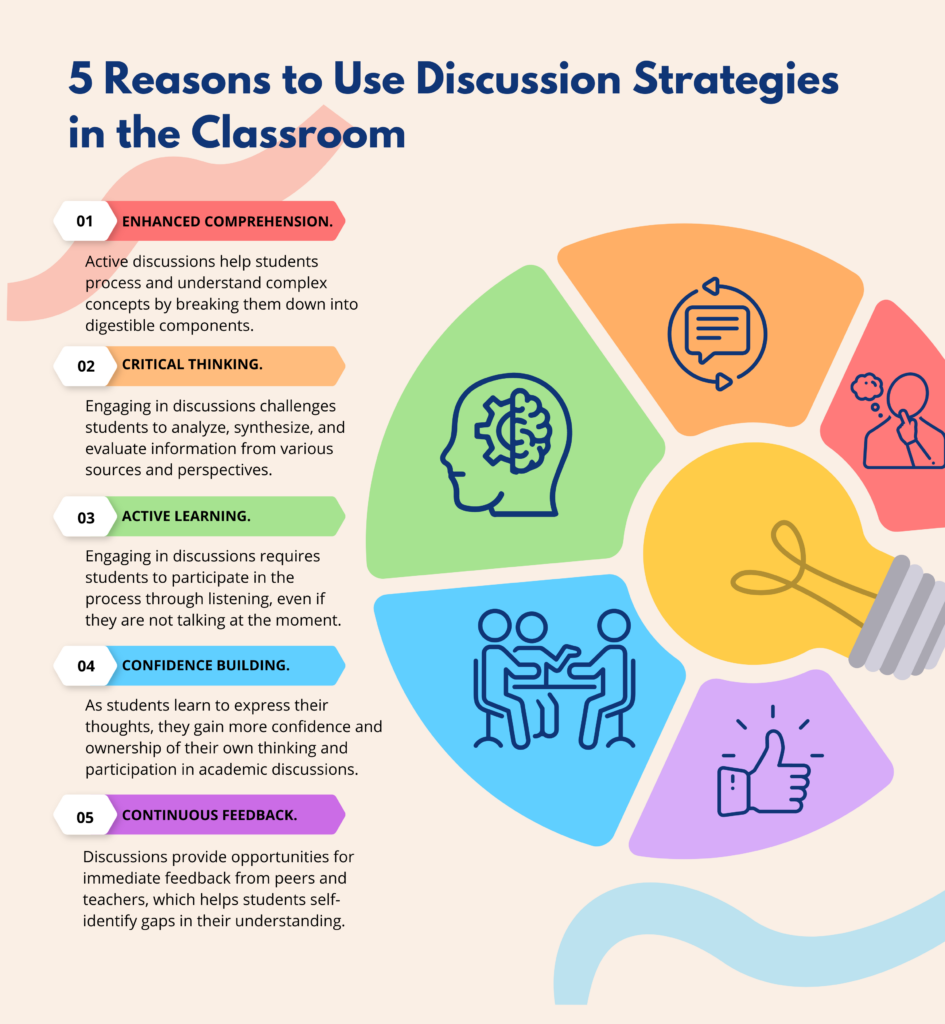
Tips to Consider When Using Discussion Strategies
If you are new to incorporating discussion strategies in your classroom, consider these tips. If you are already employing discussion strategies, then look through this list to evaluate the merit of using these tips for your discussions.
- Begin small. When using discussion strategies with students, start with very easy, non-academic topics for students to discuss. This allows them to learn how to have discussions without having to focus on important content that may be very new to them.
- Start with just one strategy. Consider which strategy might work best with your students. You may find that one strategy works great for first period but doesn’t really work for third period.
- Ask for feedback. As you start incorporating that one strategy, ask students for feedback on how they feel it is going and how it is helping them. This is also your chance to give them feedback on how to better participate in the process of this strategy.
- Vary the strategies over time. Like most good teaching strategies, variety increases engagement by adding newness and novelty. Give students time to learn the first strategy before incorporating a new one. As they learn different discussion strategies over time, you will be able to see which ones work best with your students and switch them up.
- Explain the rules clearly. In order to give students the most likelihood of success, be sure to share the rules or protocols before implementing a strategy. It may be helpful to role-play a strategy or find a YouTube video that you can share with your students to demonstrate how it works. The better they understand the rules and how to engage within that strategy’s structure, the more confident they will feel with focusing on the content and not the process of discussion.
Discussion Strategies to Try
Think-Pair-Share
If you have been in education for the last 10 years, then you have definitely seen this strategy take place. It is a very easy strategy to use and students do not have to leave their seats to participate. After doing a small bit of teaching, give your students a brief time to think about a question related to the teaching. This gives students time to formulate their thinking and process the information individually. Then, have students turn to their neighbor and share their thoughts. Students should be encouraged to ask questions and give feedback to each other in the process.
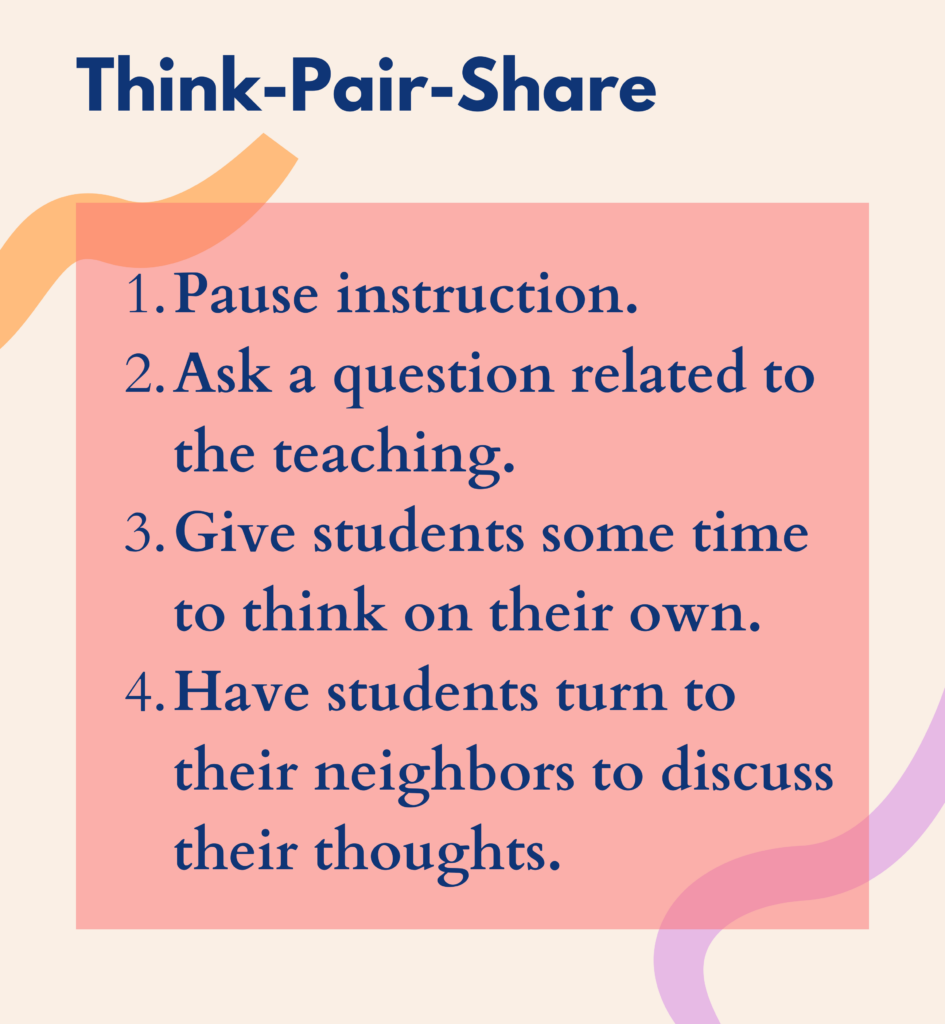
Four Corners
The nice thing about this strategy is that it has students kinesthetically engage with the content. They are more clear in their decisions and more likely to correct misconceptions. After reading a particular text or teaching, assign a different position or perspective to each corner of your room. Have students go to the one they agree with or are interested in. Students in each corner have a discussion among themselves on the position/perspective. Take this to the next level and have students pair up with someone from a different corner to cross-share their information.
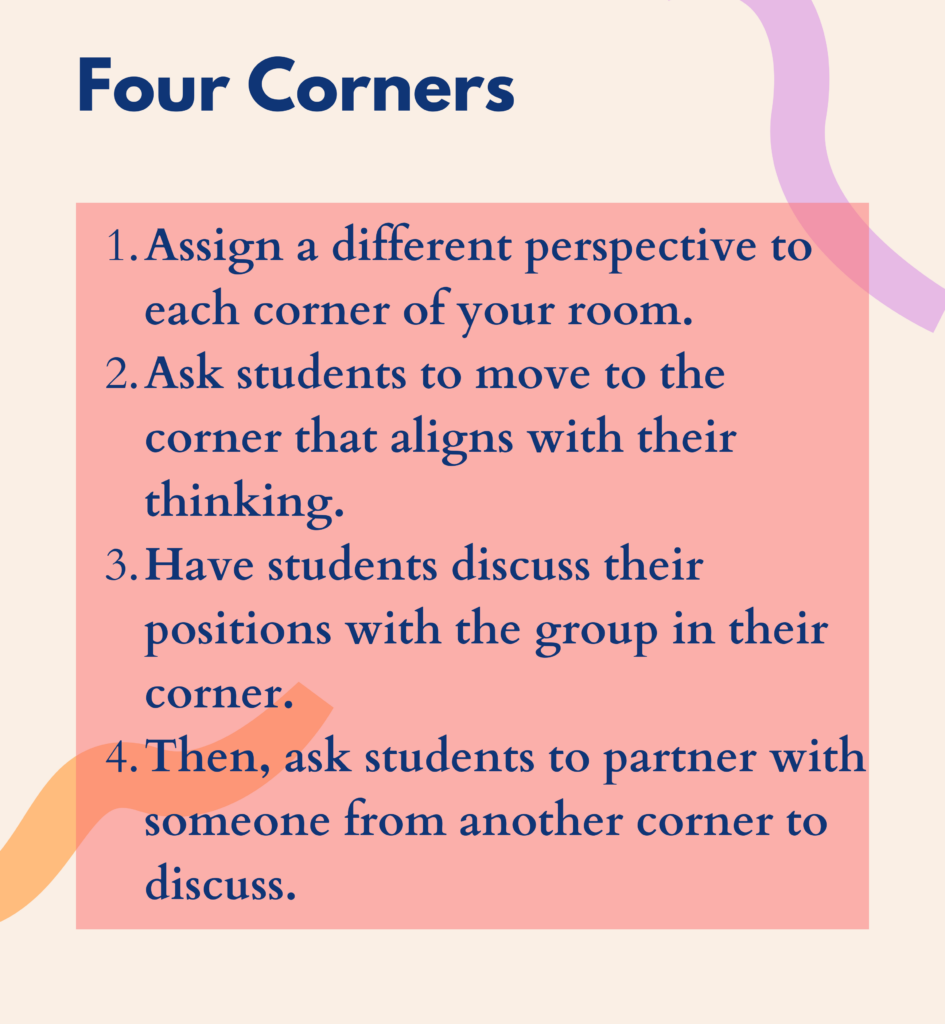
Socratic Circles
You may know this by another name, the Socratic Seminar. This technique requires that you change the seating within your classroom, so be sure to factor that in if you’re using this with a class in which you only have 45 minutes before the bell rings.
Here’s how it works:
- Choose a topic or text. The first step is to select a topic or text that you want your students to discuss. It could be anything from a current event to a piece of literature or a historical document.
- Set up the circle. Arrange the chairs in a circle and make sure there is enough space for everyone to participate. If you have a large class, you can divide them into smaller groups and set up multiple circles.
- Establish the rules. Before you begin, establish the rules for the discussion. For example, students should listen carefully to others, avoid interrupting, and speak respectfully. It’s also a good idea to set a time limit for each person’s contribution to the conversation.
- Begin the discussion. Start by asking an open-ended question about the topic or text. Encourage students to share their thoughts and ideas, and to respond to each other’s comments.
- Facilitate the discussion. As the discussion progresses, ask follow-up questions to deepen the conversation and encourage critical thinking.
- Wrap up the discussion. After the allotted time has passed, wrap up the discussion by summarizing the key points and insights that were shared. Encourage students to reflect on what they learned and how they can apply it in other contexts.
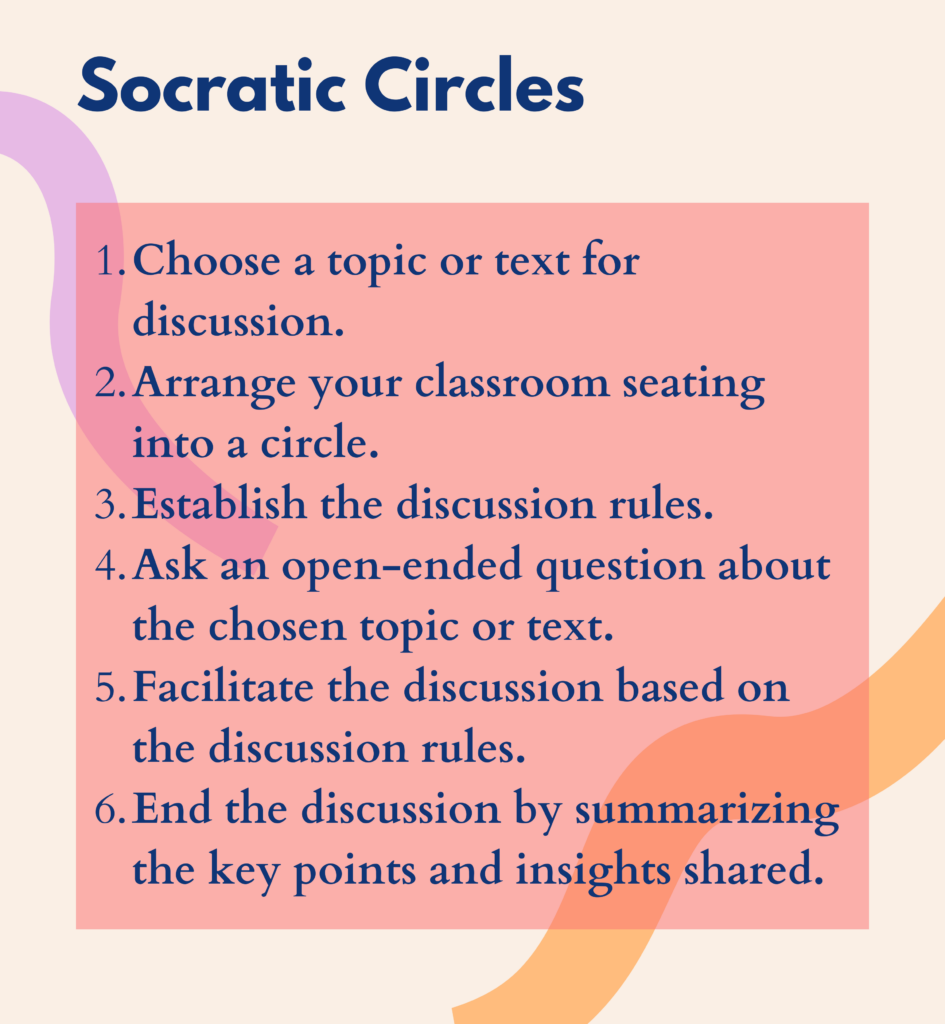
Silent Discussions
If you want students to do more mental processing before they articulate their thoughts, this may be the strategy for you to use. However, if you have students who struggle with the content or language, this may be one to test out later in the year rather than earlier. This technique takes advantage of students’ affinity for text while also giving them the opportunity to formulate their answers before sharing them with the group. Use a tech tool such as Padlet to facilitate the discussion; use the Stream format if there is just one discussion topic for whole group discussions, or consider using the Wall with Sections to facilitate several different discussions. Consider having students share their takeaways aloud in small groups to help solidify the learning.
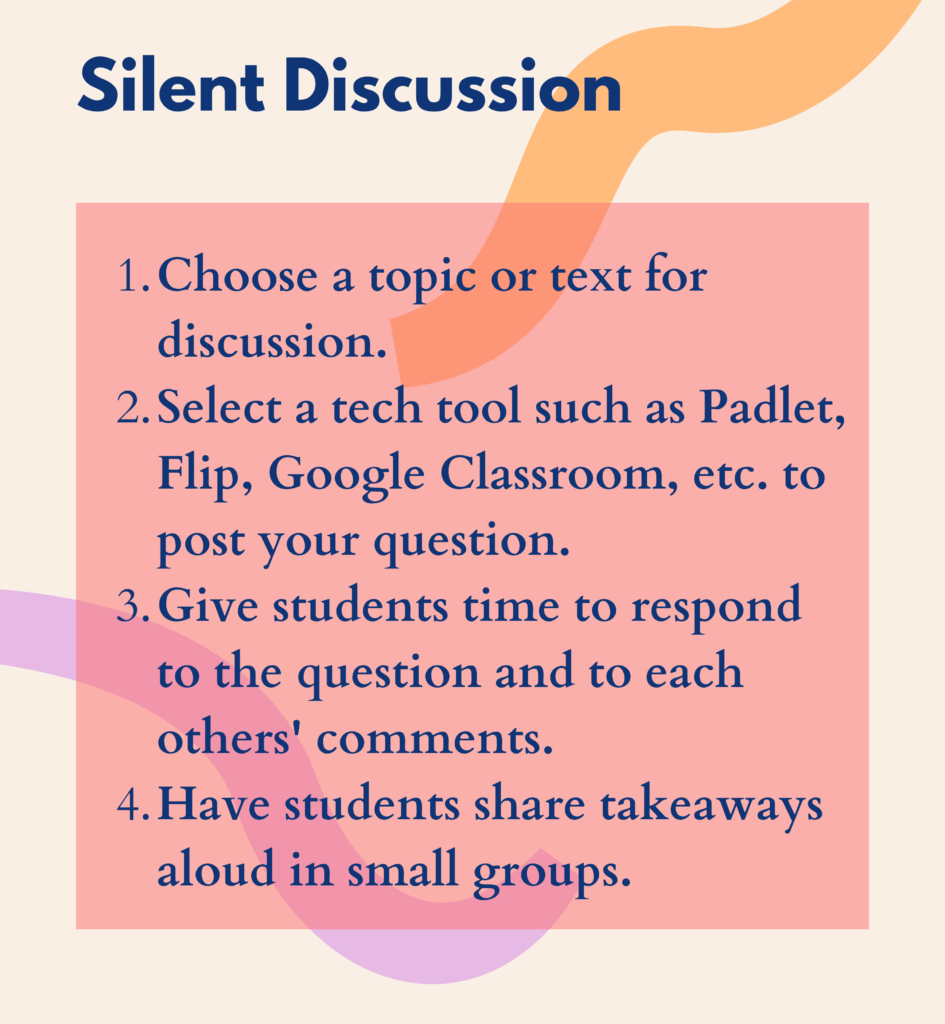
Fishbowl
While this strategy has many benefits, it does require that your students have a certain level of trust and confidence in themselves and the class. Once you have that established, this is a very effective and engaging way for students to participate in the content and learn from each other. This is also a great strategy for students who are struggling with language, since they can listen to others think out loud to better structure their thoughts and use academic vocabulary.
For this strategy, have two students sit facing each other in the middle of a circle while the rest of the class sits around them. The two middle students will have a discussion while the rest of the group listens in. Consider modeling this with another teacher or finding a good YouTube video to share with your class. Once your students become familiar with the strategy, set a random timer, and when it goes off, have one of the middle students tag another student to come in and take their place. This helps ensure that the folks on the outside have an invested interest in paying attention and thinking along with the discussion that is taking place.

Speed Dating
This strategy is great for adults and students alike. It’s very quick and requires students to share specific information within a limited time frame. If you’re working with younger students, then you might find a better reference to this strategy as Speed Talks or Drive-Through Discussions.
In this strategy, have students make two lines facing each other, so that each student is partnered with a student across from them. You could also do concentric circles if your room accommodates that better. This may better take place in the hallway outside your classroom for easier spacing. After sharing your discussion prompt, set a timer for the amount of time students will have to discuss, share reasonings, ask questions, etc. When the timer goes off, have one row move down two people, with the person on the end circling to the other end of the line. Repeat the process. Because students can easily hear their neighbors, I prefer to have them move two down the row so they hopefully hear new or different information than what their neighbors might have shared. As en extension, you can consider assigning a role to each row, with one row taking on the perspective of xyz while the other role is coming from and supporting the abc perspective.
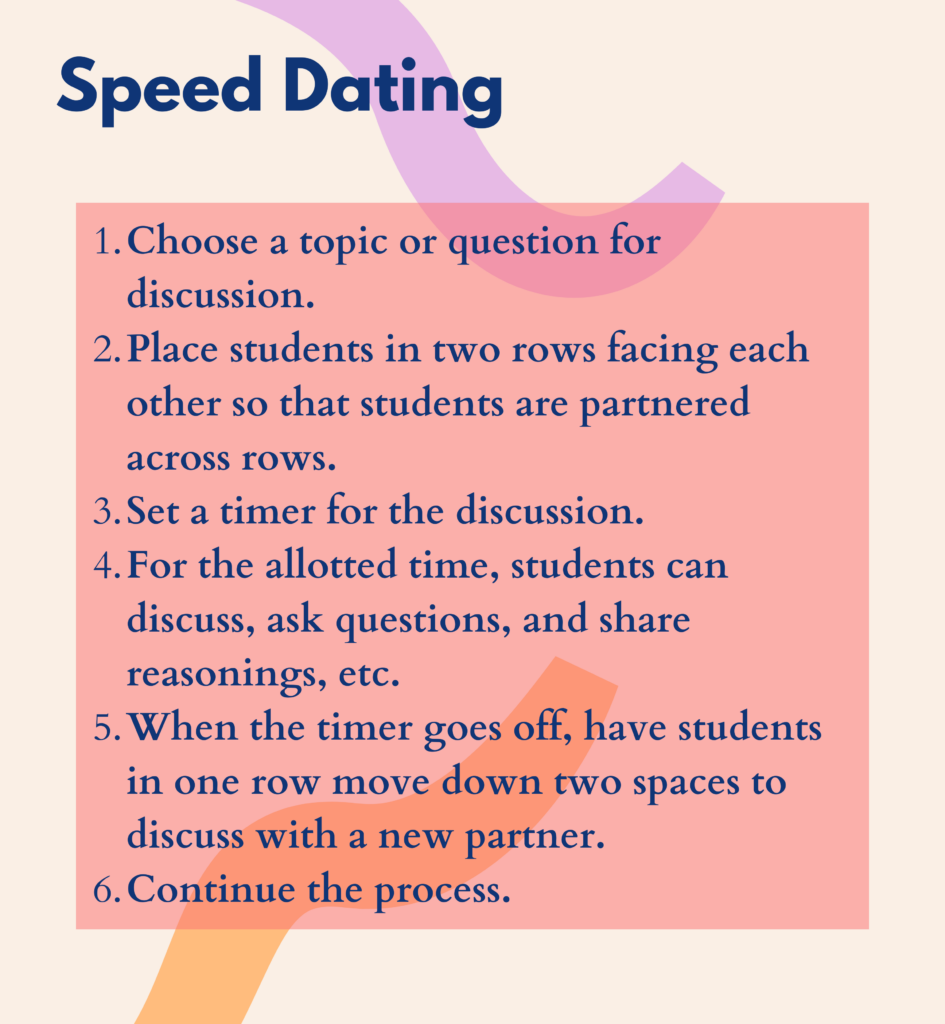
Now It’s Your Turn
Which strategy have you found most effective with your students? What about that strategy lends itself to enhancing the learning that’s taking place in the classroom? Jump in the comment section below and let us know. We realize these are just a few of the many great engaging discussion strategies that can be employed. If you know of one that we didn’t share, leave it in the comments so others can learn about it. We look forward to hearing from you!

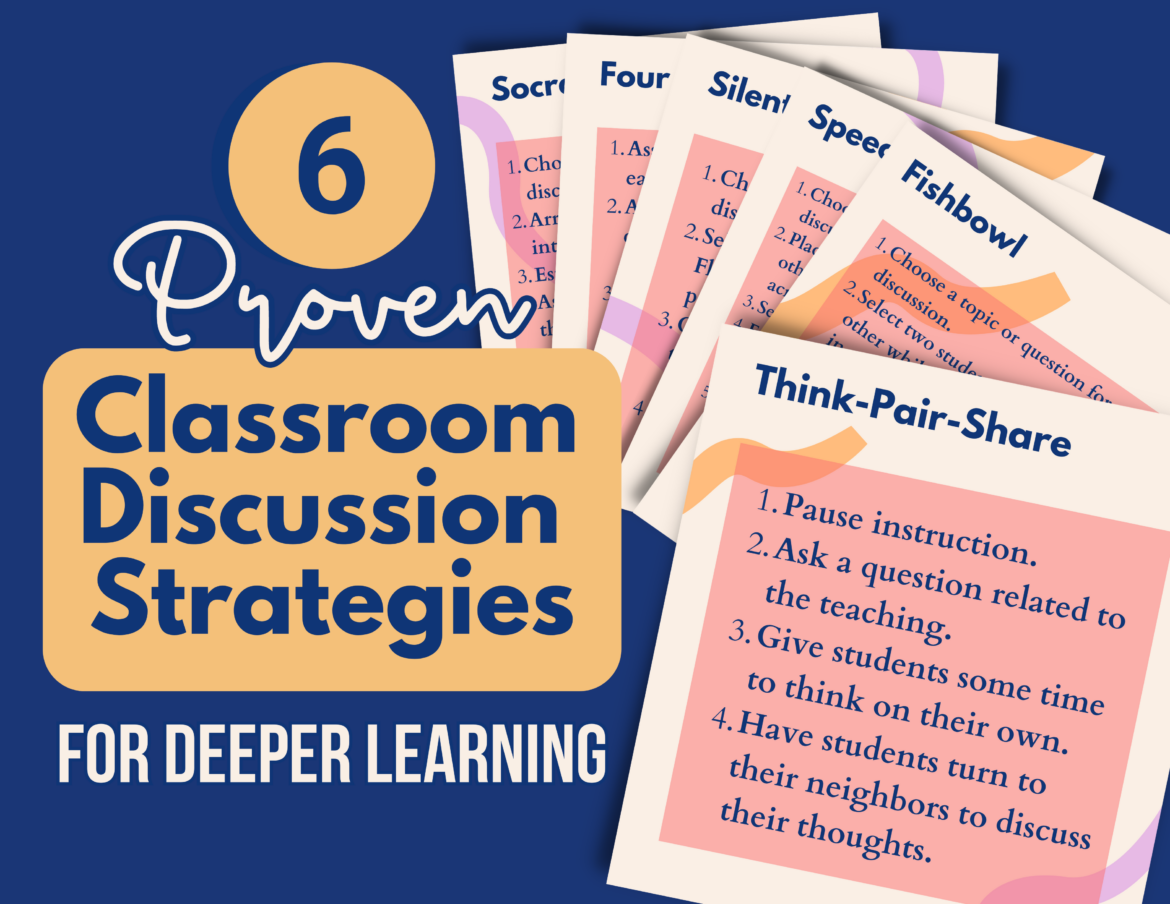
1 comment
Think pair share, students can take turns as partners